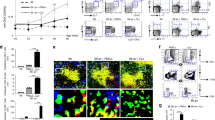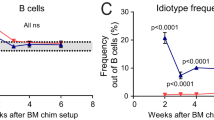Abstract
Systemic lupus erythematosus is a prototypic model for B-cell epitope spread in autoimmunity. Autoantibodies to numerous molecularly distinct self-antigens emerge in a sequential manner over several years, leading to disease manifestations. Among the earliest autoantibodies to appear are those targeting phospholipid-binding proteins, particularly β2-glycoprotein I. Notably, mice immunized with β2-glycoprotein I and lipopolysaccharide develop a strong T cell response to β2-glycoprotein I that is associated with autoantibody production and renal disease, similar to that seen in human SLE. Here we hypothesized that mice with murine systemic lupus erythematosus, whether induced or spontaneous, should have T cells that recognize β2-glycoprotein I. We evaluated the response of splenic T cells from mice with induced (C57BL/6 and C3H/HeN) and spontaneous (MRL/lpr) systemic lupus erythematosus to peptides spanning the entire sequence of human β2GPI. We found that mice with induced and spontaneous systemic lupus erythematosus recognize a common T cell epitope (peptide 31; LYRDTAVFECLPQHAMFG) in domain III of β2-glycoprotein I. β2GPI-reactive CD4+ T cells from the two models differed primarily in cytokine production: T cells from mice with induced SLE expressed IFN-γ, while T cells from MRL/lpr mice expressed both IL-17 and IFN-γ, indicating that IL-17-expressing T cells are not necessary for generating a β2GPI-reactive T cell response. These data suggest that the generation of a β2-glycoprotein I-reactive T cell response is shared by both induced and spontaneous models of systemic lupus erythematosus and that this T cell response may mediate epitope spread to autoantibodies in both models.
This is a preview of subscription content, access via your institution
Access options
Subscribe to this journal
Receive 12 digital issues and online access to articles
$119.00 per year
only $9.92 per issue
Buy this article
- Purchase on Springer Link
- Instant access to full article PDF
Prices may be subject to local taxes which are calculated during checkout






Similar content being viewed by others
References
Tsokos, G. C., Lo, M. S., Costa Reis, P. & Sullivan, K. E. New insights into the immunopathogenesis of systemic lupus erythematosus. Nat. Rev. Rheumatol. 12, 716–730 (2016).
Arbuckle, M. R. et al. Development of autoantibodies before the clinical onset of systemic lupus erythematosus. N. Engl. J. Med. 349, 1526–1533 (2003).
Levine, J. S. et al. Immunization with an apoptotic cell-binding protein recapitulates the nephritis and sequential autoantibody emergence of systemic lupus erythematosus. J. Immunol. 177, 6504–6516 (2006).
Salem, D. et al. β2-Glycoprotein I-specific T cells are associated with epitope spread to lupus-related autoantibodies. J. Biol. Chem. 290, 5543–5555 (2015).
Masutani, K. et al. Predominance of Th1 immune response in diffuse proliferative lupus nephritis. Arthritis Rheum. 44, 2097–2106 (2001).
Shin, M. S., Lee, N. & Kang, I. Effector T cell subsets in systemic lupus erythematosus: update focusing on Th17 cells. Curr. Opin. Rheumatol. 23, 444–448 (2011).
Suarez-Fueyo, A., Bradley, S. J., Klatzmann, D. & Tsokos, G. C. T cells and autoimmune kidney disease. Nat. Rev. Nephrol. 13, 329–343 (2017).
Hunemorder, S. et al. TH1 and TH17 cells promote crescent formation in experimental autoimmune glomerulonephritis. J. Pathol. 237, 62–71 (2015).
Monneaux, F., Briand, J. P. & Muller, S. B and T cell immune response to small nuclear ribonucleoprotein particles in lupus mice: autoreactive CD4(+) T cells recognize a T cell epitope located within the RNP80 motif of the 70K protein. Eur. J. Immunol. 30, 2191–2200 (2000).
Monneaux, F., Lozano, J. M., Patarroyo, M. E., Briand, J. P. & Muller, S. T cell recognition and therapeutic effect of a phosphorylated synthetic peptide of the 70K snRNP protein administered in MR/lpr mice. Eur. J. Immunol. 33, 287–296 (2003).
Kattah, N. H. et al. Tetramers reveal IL-17-secreting CD4 + T cells that are specific for U1-70 in lupus and mixed connective tissue disease. Proc. Natl Acad. Sci. USA 112, 3044–3049 (2015).
Andrews, B. S. et al. Spontaneous murine lupus-like syndromes. Clinical and immunopathological manifestations in several strains. J. Exp. Med. 148, 1198–1215 (1978).
Tolomeo, T. et al. T cells demonstrate a Th1-biased response to native β2-glycoprotein I in a murine model of anti-phospholipid antibody induction. Autoimmunity 42, 292–295 (2009).
Arai, T. et al. Autoreactive CD4(+) T cell clones to β2-glycoprotein I in patients with antiphospholipid syndrome: preferential recognition of the major phospholipid-binding site. Blood 98, 1889–1896 (2001).
Hattori, N. et al. T cells that are autoreactive to β2-glycoprotein I in patients with antiphospholipid syndrome and healthy individuals. Arthritis Rheum. 43, 65–75 (2000).
Kuwana, M. β2-glycoprotein I: antiphospholipid syndrome and T cell reactivity. Thromb. Res. 114, 347–355 (2004).
Perry, D., Sang, A., Yin, Y., Zheng, Y. Y. & Morel, L. Murine models of systemic lupus erythematosus. J. Biomed. Biotechnol. 2011, 271694 (2011).
Hashimoto, Y. et al. Anticardiolipin antibodies in NZW x BXSB F1 mice. A model of antiphospholipid syndrome. J. Immunol. 149, 1063–1068 (1992).
Verthelyi, D. & Ansar Ahmed, S. Characterization of estrogen-induced autoantibodies to cardiolipin in non-autoimmune mice. J. Autoimmun. 10, 115–125 (1997).
Peng, S. L. Experimental use of mouse models of systemic lupus erythematosus. Methods Mol. Biol. 900, 135–168 (2012).
McClain, M. T. et al. The prevalence, onset, and clinical significance of antiphospholipid antibodies prior to diagnosis of systemic lupus erythematosus. Arthritis Rheum. 50, 1226–1232 (2004).
Kuwana, M. et al. Binding of β2-glycoprotein I to anionic phospholipids facilitates processing and presentation of a cryptic epitope that activates pathogenic autoreactive T cells. Blood 105, 1552–1557 (2005).
Koga, T., Ichinose, K. & Tsokos, G. C. T cells and IL-17 in lupus nephritis. Clin. Immunol. 185, 95–99 (2017).
Yang, J. et al. Th17 and natural Treg cell population dynamics in systemic lupus erythematosus. Arthritis Rheum. 60, 1472–1483 (2009).
Dai, H., He, F., Tsokos, G. C. & Kyttaris, V. C. IL-23 limits the production of IL-2 and promotes autoimmunity in lupus. J. Immunol. 199, 903–910 (2017).
de Moerloose, P. et al. Patient-derived anti-β2GP1 antibodies recognize a peptide motif pattern and not a specific sequence of residues. Haematologica 102, 1324–1332 (2017).
Greenbaum, J. et al. Functional classification of class II human leukocyte antigen (HLA) molecules reveals seven different supertypes and a surprising degree of repertoire sharing across supertypes. Immunogenetics 63, 325–335 (2011).
Costantino, C. M., Spooner, E., Ploegh, H. L. & Hafler, D. A. Class II MHC self-antigen presentation in human B and T lymphocytes. PLoS ONE 7, e29805 (2012).
Tsai, S. & Santamaria, P. MHC class II polymorphisms, autoreactive T cells, and autoimmunity. Front. Immunol. 4, 321 (2013).
Mohan, C. & Putterman, C. Genetics and pathogenesis of systemic lupus erythematosus and lupus nephritis. Nat. Rev. Nephrol. 11, 329–341 (2015).
Acknowledgements
This study has been funded in part by operating grants from the Canadian Institutes of Health Research (CIHR; MOP-67101 and MOP-97916; J.R.) and funding from the Department of Medicine of McGill University, the Research Institute of the McGill University Health Centre, the Division of Rheumatology of McGill University, and the Arthritis Society of Canada (Rheumatic Disease Unit grant). D.S. is the recipient of a studentship from the FRQS and a Merit Fellowship from the Department of Microbiology and Immunology. J.S.L. is supported by institutional funds from Dr. José A. Arruda and the Section of Nephrology, University of Illinois at Chicago. The authors are grateful to Dr. Salman Qureshi for providing the C3H/HeN mice used in this study, and to Annie Beauchamp for her expertise and technical assistance with the mice.
Author information
Authors and Affiliations
Corresponding author
Ethics declarations
Competing interests
The authors declare no competing interests.
Additional information
Publisher's note: Springer Nature remains neutral with regard to jurisdictional claims in published maps and institutional affiliations.
Electronic supplementary material
Rights and permissions
About this article
Cite this article
Salem, D., Subang, R., Kuwana, M. et al. T cells from induced and spontaneous models of SLE recognize a common T cell epitope on β2-glycoprotein I. Cell Mol Immunol 16, 685–693 (2019). https://doi.org/10.1038/s41423-018-0013-3
Received:
Revised:
Accepted:
Published:
Issue Date:
DOI: https://doi.org/10.1038/s41423-018-0013-3
Keywords
This article is cited by
-
Complementary proteome and glycoproteome access revealed through comparative analysis of reversed phase and porous graphitic carbon chromatography
Analytical and Bioanalytical Chemistry (2022)
-
IL-17 sustains the plasma cell response via p38-mediated Bcl-xL RNA stability in lupus pathogenesis
Cellular & Molecular Immunology (2021)
-
Increased MLKL mRNA level in the PBMCs is correlated with autoantibody production, renal involvement, and SLE disease activity
Arthritis Research & Therapy (2020)
-
Different domains of β2-glycoprotein I play a role in autoimmune pathogenesis
Cellular & Molecular Immunology (2020)
-
BCL-6 suppresses miR-142-3p/5p expression in SLE CD4+ T cells by modulating histone methylation and acetylation of the miR-142 promoter
Cellular & Molecular Immunology (2020)



